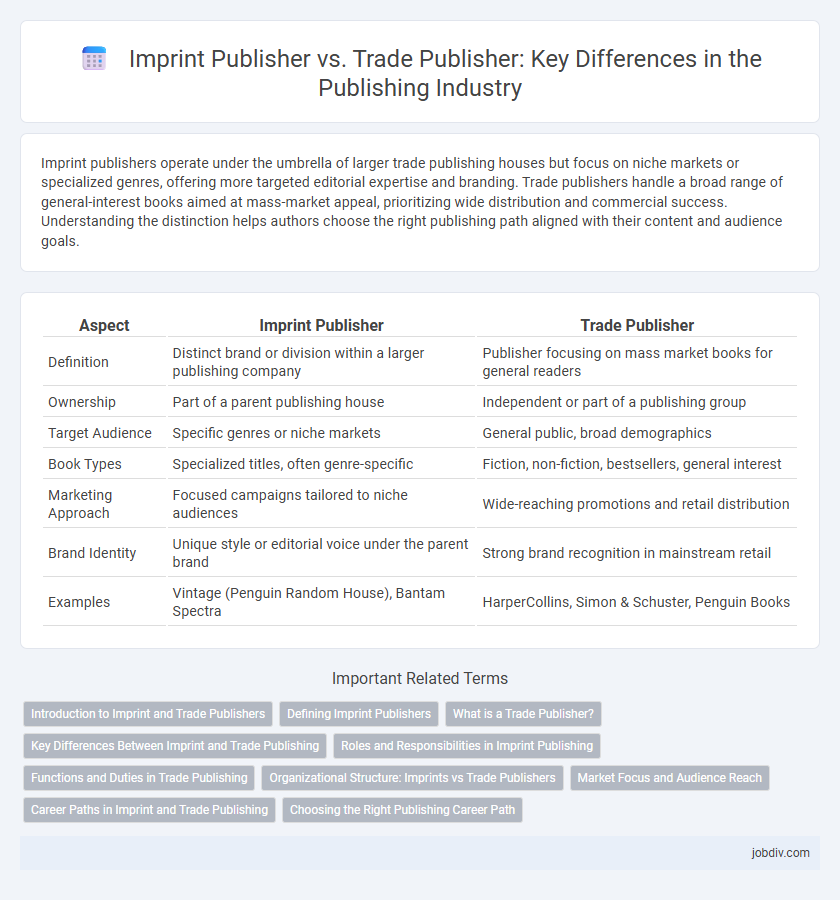Imprint publishers operate under the umbrella of larger trade publishing houses but focus on niche markets or specialized genres, offering more targeted editorial expertise and branding. Trade publishers handle a broad range of general-interest books aimed at mass-market appeal, prioritizing wide distribution and commercial success. Understanding the distinction helps authors choose the right publishing path aligned with their content and audience goals.
Table of Comparison
| Aspect | Imprint Publisher | Trade Publisher |
|---|---|---|
| Definition | Distinct brand or division within a larger publishing company | Publisher focusing on mass market books for general readers |
| Ownership | Part of a parent publishing house | Independent or part of a publishing group |
| Target Audience | Specific genres or niche markets | General public, broad demographics |
| Book Types | Specialized titles, often genre-specific | Fiction, non-fiction, bestsellers, general interest |
| Marketing Approach | Focused campaigns tailored to niche audiences | Wide-reaching promotions and retail distribution |
| Brand Identity | Unique style or editorial voice under the parent brand | Strong brand recognition in mainstream retail |
| Examples | Vintage (Penguin Random House), Bantam Spectra | HarperCollins, Simon & Schuster, Penguin Books |
Introduction to Imprint and Trade Publishers
Imprint publishers operate as specialized brands or divisions under a larger publishing company, often targeting niche markets or specific genres to build distinct identities. Trade publishers focus on producing and distributing books primarily aimed at the general consumer market through retail outlets, including bookstores, online platforms, and libraries. Understanding the difference highlights how imprints allow diversification within a parent company while trade publishers emphasize broad commercial reach.
Defining Imprint Publishers
Imprint publishers function as specialized brand names under the umbrella of a larger publishing company, targeting specific market segments or genres to enhance brand identity and market reach. Unlike trade publishers who operate independently with a broad scope, imprint publishers tailor their editorial vision, design, and marketing strategies to resonate with niche audiences, often fostering stronger reader loyalty. The strategic use of imprints allows major publishers to diversify their catalogues while maintaining distinct editorial voices and industry recognition within competitive markets.
What is a Trade Publisher?
A trade publisher is a company that produces and distributes books primarily aimed at general readers, including fiction, non-fiction, and children's titles. They focus on marketable, commercially viable content that appeals to a broad audience and are responsible for editing, design, marketing, and sales through bookstores and online retailers. Unlike imprint publishers, trade publishers handle the entire publishing process under their brand, leveraging industry connections to maximize book exposure and distribution.
Key Differences Between Imprint and Trade Publishing
Imprint publishers operate as specialized brand subdivisions within larger publishing houses, focusing on niche markets or specific genres to tailor their marketing and editorial strategies. Trade publishers handle the broader commercial book market, producing titles intended for mass retail distribution and general readership. Key differences between imprint and trade publishing include the scope of audience targeting, editorial autonomy, and marketing approaches, with imprints often allowing more creative freedom and trade publishers emphasizing high-volume sales.
Roles and Responsibilities in Imprint Publishing
Imprint publishers focus on developing distinct brand identities within a larger publishing house, curating specialized content that targets niche markets or genres. Their responsibilities include acquiring manuscripts, overseeing editorial processes, coordinating marketing strategies, and maintaining the unique voice and standards of the imprint. Trade publishers, conversely, manage broader commercial publishing operations, focusing on mass-market appeal and distribution, while imprint publishers concentrate on fostering creative vision and audience engagement in specific categories.
Functions and Duties in Trade Publishing
Trade publishers focus on acquiring, producing, and marketing books aimed at general consumers, managing tasks such as editorial development, design, distribution, and sales. Their duties include negotiating rights, coordinating print and digital formats, and executing promotional campaigns to maximize market reach and profitability. Imprint publishers, by contrast, operate under larger publishing houses, specializing in specific genres or audiences while leveraging the parent company's resources for production and distribution.
Organizational Structure: Imprints vs Trade Publishers
Imprint publishers function as specialized brands within a larger publishing house, allowing targeted marketing and editorial focus while sharing centralized resources such as distribution and management. Trade publishers operate as independent entities with comprehensive organizational structures, including dedicated departments for editorial, marketing, sales, and rights management. The imprint model enhances niche market penetration by leveraging the parent company's infrastructure, whereas trade publishers manage all operational components autonomously to maintain full control over their publishing process.
Market Focus and Audience Reach
Imprint publishers target niche markets with specialized genres, offering a focused audience reach tailored to specific reader preferences. Trade publishers aim for broader mass-market distribution, reaching diverse demographics through general interest books and mainstream genres. Market focus distinguishes their strategies, with imprints prioritizing depth in particular segments while trade publishers emphasize widespread visibility and sales volume.
Career Paths in Imprint and Trade Publishing
Career paths in imprint publishing often emphasize specialization within niche genres or markets, allowing professionals to develop deep expertise in brand development and audience targeting. Trade publishing careers typically involve broader market reach and demand skills in commercial strategy, sales coordination, and mass-market appeal. Professionals in imprint publishing may progress from editorial roles to brand management, while trade publishing offers advancement through marketing, sales, and executive leadership positions.
Choosing the Right Publishing Career Path
Choosing between an imprint publisher and a trade publisher depends on your career goals and interests in the publishing industry. Imprint publishers focus on niche markets, allowing for specialization in specific genres or audiences, while trade publishers handle a broad range of commercial titles aimed at mass markets. Understanding these differences helps aspiring professionals align their skills with roles in editorial, marketing, or rights management tailored to either specialized or mainstream publishing environments.
Imprint Publisher vs Trade Publisher Infographic

 jobdiv.com
jobdiv.com